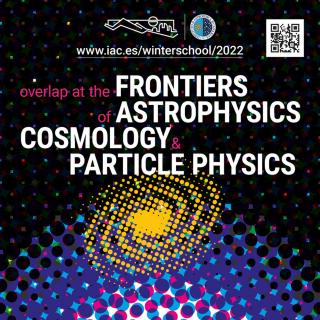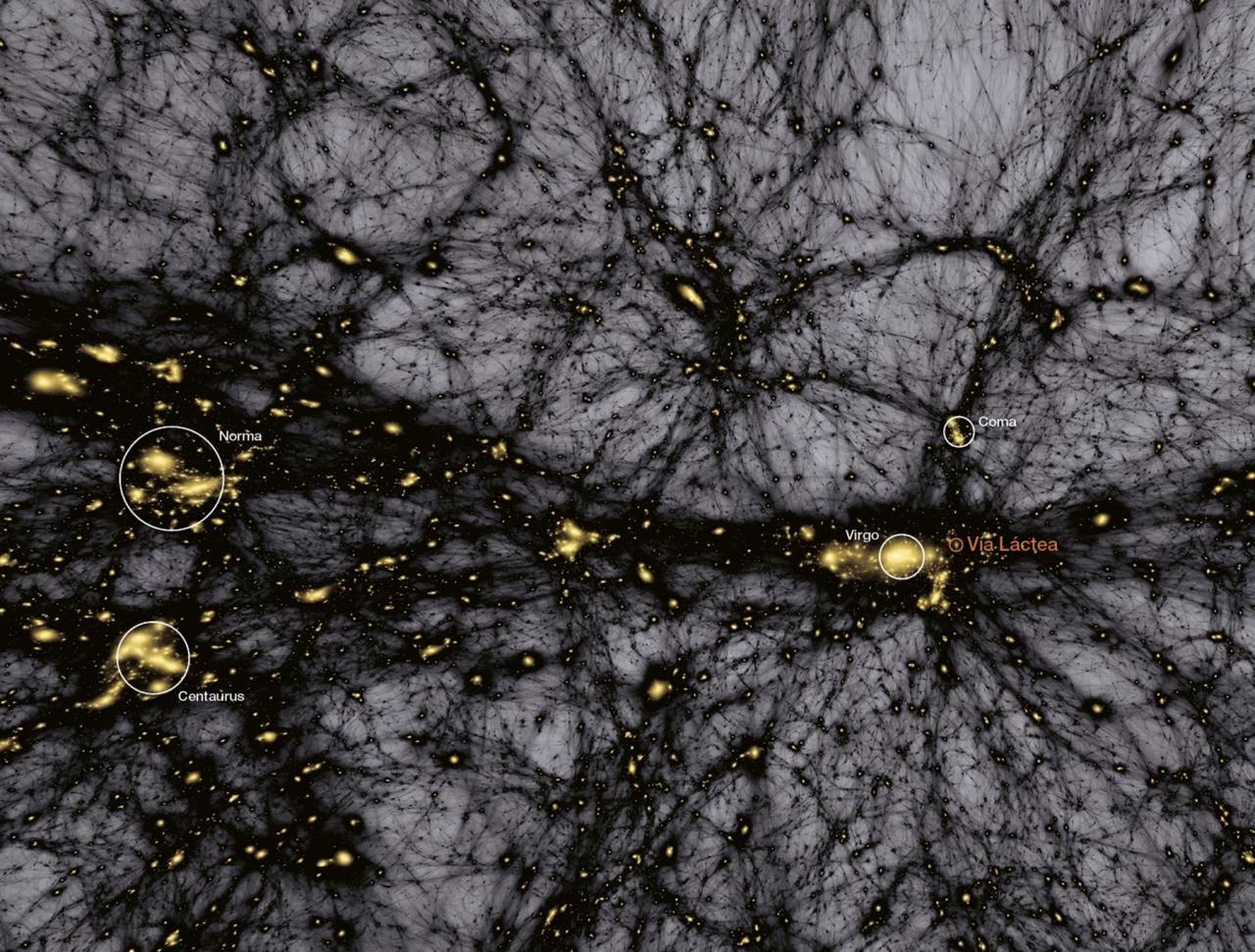Grants related:
General
The Cosmic Microwave Background (CMB) contains the statistical information about the early seeds of the structure formation in our Universe. Its natural counterpart in the local universe is the distribution of galaxies that arises as a result of gravitational growth of those primordial and small density fluctuations. The characterization of the distribution of inhomogeneities at large-scale in the local Universe provides a powerful tool, complementary to the CMB, to determine the origin and the energy content of the Universe, the expansion rate of the Universe during the cosmic history, and the detailed process of formation of the large-scale structures (LSS). The study of the LSS in the coming years will attempt to address the following open questions in cosmology:
What is the dark matter, and which is its detailed contribution to the energy content of the Universe?
What is the dark energy, and how it affects the dynamics of the Universe?
What is the connection between large scale structure and galaxy formation?
Do fundamental constants vary along the history of the Universe?
Is there evidence for primordial non-Gaussianities giving information on the details of the inflationary expansion epoch of the Universe?
In order to contribute to the possible answer to those questions, in this project we will use several large scale structure probes:
The distribution and large-scale clustering of the galaxies, and its evolution with time. The matter power spectrum (P(k)) and the two-point correlation function (ξ(r)) contain certain geometric features associated to some characteristic length-scales in the Universe, as the horizon at matter-radiation equality, or the acoustic horizon at last scattering. In particular, the latter determines the Baryon Acoustic Oscillation (BAO) scale.
The higher order statistics: the three-point statistics characterizes the deviation from Gaussinity and therefore the structure formation through gravitational instability, the galaxy bias, and the primordial non-Gaussianities.
The distribution of the cosmic voids in the Universe. Both the statistics of big voids, as well as the characterization of the void expansion, provides a complementary tool to determine the matter density and the equation of state of the dark energy. Cosmic voids contain information of the higher order statistics of galaxies and can be used to further constrain the BAO scale.
The cosmic web can be used to characterize the formation of structures and relate the large scale structure with galaxy formation processes.
The distribution and abundance of galaxy clusters, as well as the evolution with time. Among other parameters, the cluster mass function depends both on the matter density as well as in the amplitude of the power spectrum. The time evolution of the mass function n(M,z) is also govern by the growth of structures in the Universe, thus being also sensitive to the equation of state of the dark energy.
Members
Results
- eBOSS: cosmological analysis from the quasar sample. Marcos Pellejero Ibañez and F. S. Kitaura participated in the construction of the likelihood and the cosmological parameter estimation (including as coauthors Kitaura & Pellejero Ibañez: 2018MNRAS.473.4773A).
- EUCLID: comparison project of mock galaxy catalogue generating codes showing the accuracy and speed of the PATCHY code (including as coauthors Balaguera-Antolínez, Kitaura & Pellejero Ibañez:https://arxiv.org/abs/1806.09497, https://arxiv.org/abs/1806.09477, https://arxiv.org/abs/1806.09499)
- Development of an accurate Bias mapping method for large scale structure analysis (Balaguera-Antolínez, Kitaura, Pellejero Ibañez et al 2018:https://arxiv.org/abs/1806.05870)
- Presentation of the UNITSIM project to provide simulations for the theoretical model comparison for DESI and EUCLID (including as coauthors Kitaura & Pellejero Ibañez:http://www.unitsims.org/ https://arxiv.org/abs/1811.02111)
- Presentation of BARCODE (Bos, Kitaura & Weygaert 2018: https://arxiv.org/abs/1810.05189, http://adsabs.harvard.edu/abs/2018ascl.soft10002B)
Scientific activity
Related publications
-
Planck intermediate results. V. Pressure profiles of galaxy clusters from the Sunyaev-Zeldovich effect
Taking advantage of the all-sky coverage and broadfrequency range of the Planck satellite, we study the Sunyaev-Zeldovich (SZ) and pressure profiles of 62 nearby massive clusters detected at high significance in the 14-month nominal survey. Careful reconstruction of the SZ signal indicates that most clusters are individually detected at least out
Delabrouille, J. et al.Advertised on:
22013 -
Planck intermediate results. VIII. Filaments between interacting clusters
Context. About half of the baryons of the Universe are expected to be in the form of filaments of hot and low-density intergalactic medium. Most of these baryons remain undetected even by the most advanced X-ray observatories, which are limited in sensitivity to the diffuse low-density medium. Aims: The Planck satellite has provided hundreds of
Zacchei, A. et al.Advertised on:
22013 -
The Baryon Oscillation Spectroscopic Survey of SDSS-III
The Baryon Oscillation Spectroscopic Survey (BOSS) is designed to measure the scale of baryon acoustic oscillations (BAO) in the clustering of matter over a larger volume than the combined efforts of all previous spectroscopic surveys of large-scale structure. BOSS uses 1.5 million luminous galaxies as faint as i = 19.9 over 10,000 deg2 to measure
Kauffmann, Guinevere et al.Advertised on:
12013 -
The Ninth Data Release of the Sloan Digital Sky Survey: First Spectroscopic Data from the SDSS-III Baryon Oscillation Spectroscopic Survey
The Sloan Digital Sky Survey III (SDSS-III) presents the first spectroscopic data from the Baryon Oscillation Spectroscopic Survey (BOSS). This ninth data release (DR9) of the SDSS project includes 535,995 new galaxy spectra (median z ~ 0.52), 102,100 new quasar spectra (median z ~ 2.32), and 90,897 new stellar spectra, along with the data
Sheldon, Erin et al.Advertised on:
122012 -
Structure of Abell 1995 from optical and X-ray data: a galaxy cluster with an elongated radio halo
Context. Abell 1995 is a puzzling galaxy cluster hosting a powerful radio halo, but it has not yet been recognized as a obvious cluster merger, as usually expected for clusters with diffuse radio emission. Aims: We aim at an exhaustive analysis of the internal structure of Abell 1995 to verify that this cluster is really dynamically relaxed, as
Boschin, W. et al.Advertised on:
112012 -
Dark Matter, Magnetic Fields, and the Rotation Curve of the Milky Way
The study of the disk rotation curve of our Galaxy at large distances provides an interesting scenario for us to test whether magnetic fields should be considered as a non-negligible dynamical ingredient. By assuming a bulge, an exponential disk for the stellar and gaseous distributions, and a dark halo and disk magnetic fields, we fit the rotation
Ruiz-Granados, B. et al.Advertised on:
82012 -
The clustering of galaxies in the SDSS-III Baryon Oscillation Spectroscopic Survey: cosmological implications of the large-scale two-point correlation function
We obtain constraints on cosmological parameters from the spherically averaged redshift-space correlation function of the CMASS Data Release 9 (DR9) sample of the Baryonic Oscillation Spectroscopic Survey (BOSS). We combine this information with additional data from recent cosmic microwave background (CMB), supernova and baryon acoustic oscillation
Sánchez, Ariel G. et al.Advertised on:
92012 -
Cosmological constraints on nonstandard inflationary quantum collapse models
We briefly review an important shortcoming—unearthed in previous works—of the standard version of the inflationary model for the emergence of the seeds of cosmic structure. We consider here some consequences emerging from a proposal inspired on ideas of Penrose and Diósi [R. Penrose, The Emperor’s New Mind. Concerning Computers, Minds and Laws of
Landau, Susana J. et al.Advertised on:
62012 -
Planck intermediate results. I. Further validation of new Planck clusters with XMM-Newton
We present further results from the ongoing XMM-Newton validation follow-up of Planck cluster candidates, detailing X-ray observations of eleven candidates detected at a signal-to-noise ratio of 4.5 < S/N < 5.3 in the same 10-month survey maps used in the construction of the Early SZ sample. The sample was selected in order to test internal SZ
Planck Collaboration et al.Advertised on:
72012 -
The Orientation of Disk Galaxies around Large Cosmic Voids
Using a large sample of galaxies from the the seventh data release of the Sloan Digital Sky Survey (SDSS-DR7), we have analyzed the alignment of disk galaxies around cosmic voids. We have constructed a complete sample of cosmic voids (devoid of galaxies brighter than Mr - 5log h = -20.17) with radii larger than 10 h -1 Mpc up to redshift 0.12. Disk
Varela, J. et al.Advertised on:
12012 -
Quantifying the coherent outflows of galaxies around voids in the SDSS DR7
We report the detection, with a high level of confidence, of coherent outflows around voids found in the seventh data release of the Sloan Digital Sky Survey (SDSS DR7). In particular, we developed a robust ⟨|cos θ|⟩ statistical test to quantify the strength of redshift-space distortions (RSD) associated with extended coherent velocity fields. We
Patiri, S. G. et al.Advertised on:
52012 -
Halo concentrations in the standard Λ cold dark matter cosmology
We study the concentration of dark matter haloes and its evolution in N-body simulations of the standard Λ cold dark matter (ΛCDM) cosmology. The results presented in this paper are based on four large N-body simulations with ˜10 billion particles each: the Millennium-I and -II, Bolshoi and MultiDark simulations. The MultiDark (or BigBolshoi)
Prada, Francisco et al.Advertised on:
72012 -
Environmental effects on the bright end of the galaxy luminosity function in galaxy clusters
Context. The dependence of the luminosity function (LF) of cluster galaxies on the evolutionary state of the parent cluster is still an open question, in particular concerning the formation/evolution of the brightest cluster galaxies. Aims: We study the bright part of the LFs of a sample of very unrelaxed clusters ("DARC" clusters showing evidence
Barrena, R. et al.Advertised on:
42012 -
Abell 1758N from an optical point of view: new insights on a merging cluster with diffuse radio emission
Context. The mechanisms producing the diffuse radio emission in galaxy clusters, and in particular their connection with cluster mergers, are still debated. Aims: We seek to explore the internal dynamics of the cluster Abell 1758N, which has been shown to host a radio halo and two relics, and is known to be a merging bimodal cluster. Methods: Our
Boschin, W. et al.Advertised on:
42012
Related talks
No related talks were found.Related conferences
-
 XXXIII Canary Islands Winter School of Astrophysics: Astroparticle Physics and Cosmology
XXXIII Canary Islands Winter School of Astrophysics: Astroparticle Physics and CosmologyThe XXXIII Canary Islands Winter School of Astrophysics, organized by the Instituto de Astrofísica de Canarias (IAC), focuses on Astroparticle Physics and Cosmology. The school, to be held in San
"Salón de actos" at the Museo de la Ciencia y el Cosmos (MCC) Avda. Los Menceyes 70 38205 San Cristóbal de La LagunaSpainDate-Past


